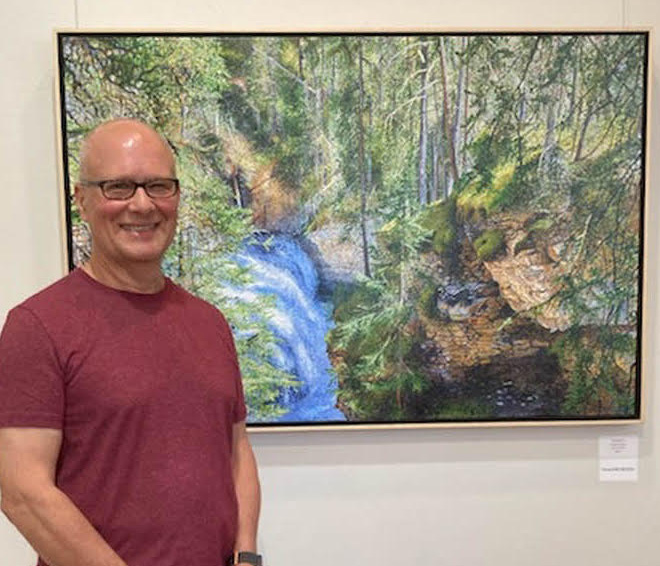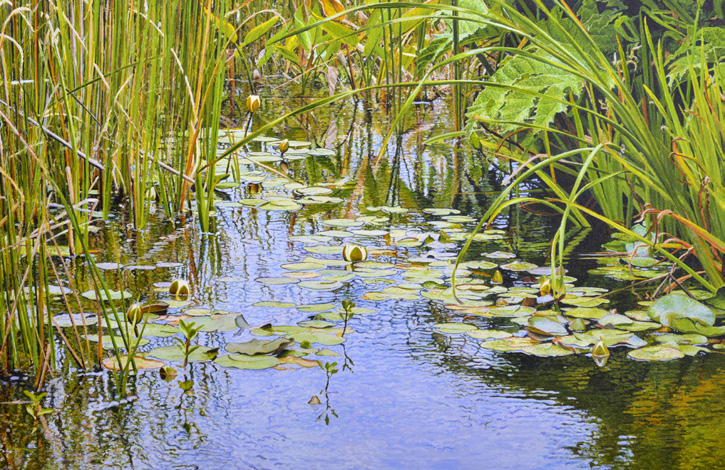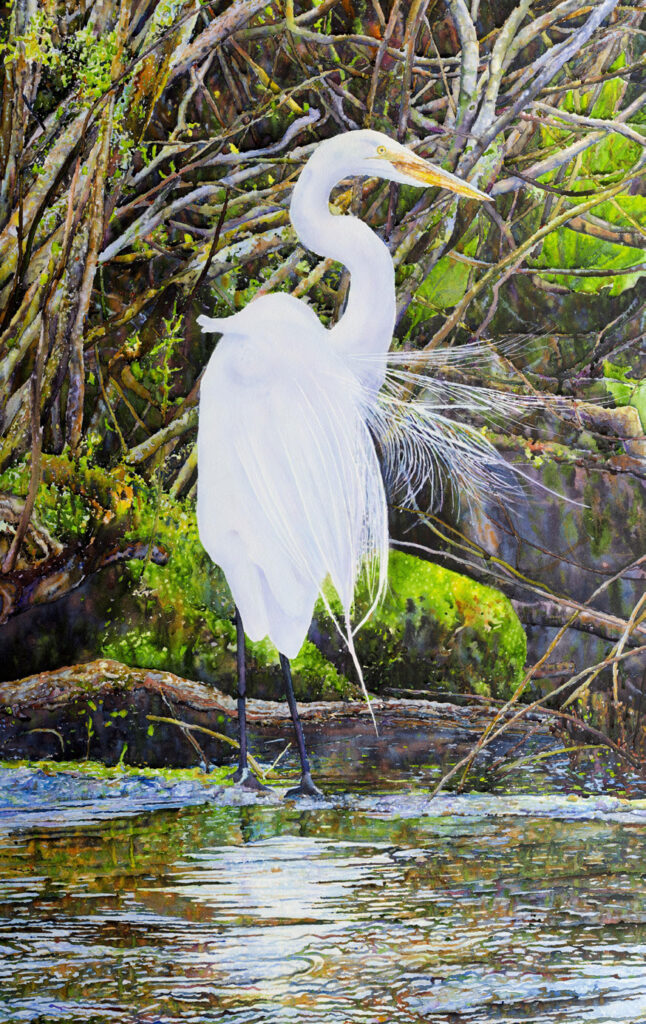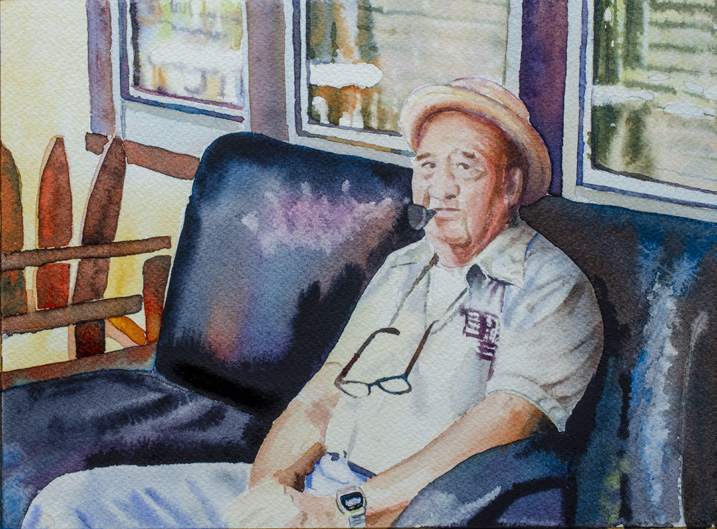
Born and raised in Brooklyn, New York, in the 1950s, the landscape painter Ross Barbera grew up in the energy of The City but spent his summers at his family’s homes in Smithtown on Long Island and the sleepy village of Peakville in upstate New York. It was during those summers that he discovered the world of the natural landscape, and it’s proven to be the inspiration for his art ever since. A visit to Barbera’s website –rossbarbera.com– however shows the rich variety of his work, including portraits, beautifully wrought quilts, jewelry, and watercolors. I recently sat down with Ross to discuss his work.
BT: I’m familiar with some of your early work, done when you were an undergraduate at St. John’s University in Jamaica, NY. How is that work different from what you were to do for much of the rest of your career?
RB: As an undergraduate student, I experimented with both realism and abstraction. By junior year of college, my artistic identity began to solidify, and I had decided on the direction for my senior thesis. My undergraduate thesis paintings were airbrushed abstractions, suggestive of imaginary landscape environments. I called these paintings “Mindscapes.” During the summer of 1973, having graduated from St. John’s University, and having spent a significant amount of time photographing, painting, and drawing in upstate New York, my close-up observations of freshwater pond and stream surfaces led me to discover similarities between these surfaces and my abstract paintings. Becoming fascinated with closeup views of freshwater surfaces, it was during this summer that my work transitioned from abstraction to realistic landscape painting. By the time I entered graduate school in the fall of 1973, water surfaces had become my primary subject to paint. For my MFA thesis in 1975, I produced a series of large representational paintings capturing close-up views of still pond surfaces. That fall, I had my first solo exhibition at Razor Gallery in SoHo, NYC, and that show featured my large waterscape paintings.
BT: A great deal of that early canvas work uses air brush; is that still the case?
RB: The use of an airbrush was critical to my early paintings primarily because I wished to eliminate visible brushstrokes and create painted surfaces characterized by smooth modulations of color and form. The airbrush was the perfect tool to achieve this. “American Artist Magazine” featured my freehand airbrush painting methods in an article sometime during the 1980s. By the late 1980s, I realized that painting in oils with an airbrush had the potential to create significant health issues, so I abandoned the airbrush and started [using] traditional paint brushes. Around that time, I also switched from oils to acrylics to eliminate toxic solvents from my studio. The transition […] was a difficult [period] for me. This was an abrupt switch at a time when I was actively working on paintings for several solo exhibitions. In midstream, I needed to reinvent myself as a painter. Most challenging was the transition from airbrushed surfaces with a photographic look, to painterly surfaces in which individual brushstrokes remained distinct.

BT: You eventually taught at St. John’s, ultimately becoming the chair of the Fine Arts Department (now called the Dept. of Art and Design). Did your work as a professor and administrator affect or influence your work as an artist?
RB: The two were so entwined, I’m not sure what influenced what. It’s clear to me that during the early part of my college teaching career, I developed an appreciation for Art History, and I began to see the individual practicing artist not as an isolated entity, but as part of a much larger historical tapestry. I [also] see an influence that my work as an educator had on my jewelry.

BT: Ah, jewelry. Let’s talk more about that. Many people know your wonderful jewelry through your YouTube channel “Realisticart,” Is that channel and your jewelry still an aspect of your creativity?
RB: To date, my YouTube channel “RealisticArt” hosts almost 100 self-authored videos dedicated to Jewelry Design and Watercolor Painting. I suspended video production about four years ago to concentrate more fully on painting. Video production is labor intensive and cut significantly into my available painting time. But now that I’ve retired from full time teaching, I plan to start work on a new video series exploring recent developments in my methods for constructing paper jewelry and will also be introducing a new series on Acrylic Painting.

BT: Back to painting. Much of your work on canvas –even your early work from the 1970s, is very large in scale. Can you talk about that?
RB: From the mid-1970s to the early 1980s the standard size for my paintings was 72″ x 72″. During the early 1980s, I transitioned to canvases measuring 72″ x 48″, and most of my work until the early 2000s falls within that format. During the past few years, I scaled my paintings down to 36″ x 48″, but I’m considering returning to a 6-foot format during 2022. I already have the canvas stretchers.
BT: So, why the large scale?
RB: [Because] large-scale paintings alter the viewing space of a room, impacting on its visual environment. When someone walks into a room, I want my painting to reach out and invite them for a closer look. My intent is to build painted surfaces that are satisfying to look at not only from a distance, but that upon close examination, reveal a microcosm of fascinating brush strokes. I remember my first solo exhibition at Razor Gallery in SoHo. For that exhibition I produced a series of 72″ x 72″ canvases depicting close-up views of water surfaces. People came into the gallery to look at my paintings simply because they happened to be walking down West Broadway and were attracted by what they saw from outside!

[But] in addition to my large work, I also produce small acrylic and watercolor paintings. The small pieces provide relief from my labor-intensive large canvases and give me an opportunity to experiment with a range of ideas in a relatively short period of time.
BT: And finally, borrowing from the late, great James Lipton, who always ended his interviews on The Actor’s Studio with his now-famous Ten Questions, I’d love to hear your “top-of-the-head” responses to those questions.
The first one is: What’s your favorite word?
RB: Yes
BT: What’s your least favorite word?
RB: Cannot
BT: What turns you on?
RB: Early Morning
BT: What turns you off?
RB: Bad Coffee
BT: What sound or noise do you love?
RB: Blowing Snow
BT: What sound or noise do you hate?
RB: Buzzing of a Mosquito
BT: What’s your favorite curse word?
RB: Shit.
BT: What profession other than your own would you like to attempt?
RB: Jazz Drummer
BT: What profession would you not like to do?
RB: Dental Hygienist
BT: If heaven exists, what would you like to hear God say when you arrive at the Pearly Gates?
RB: What took you so long? G&S
For an expanded version of this interview, visit Barbera’s website: www.rossbarbera.com





Leave a Comment